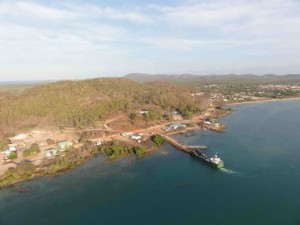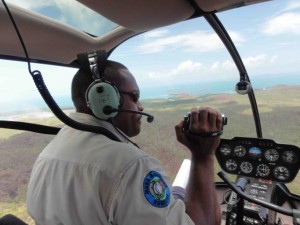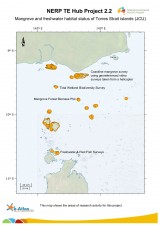NERP TE Project 2.2 - Mangrove and freshwater habitat status of Torres Strait islands (JCU)
Project summary
This project examined the status, diversity and condition of mangroves and freshwater habitats in the Torres Strait. This provided a baseline against which future changes can be assessed and will also enable planning for adaptation to potential sea level rise/increased storm surge. The project built on Torres Strait Islanders' knowledge and understanding of mangrove habitats, with scientists working in partnership with Traditional Owners.
This project is not complete.
Why this research is needed
Torres Strait islands have extensive mangrove margins and several islands are predominantly made up of intertidal swamps. But there has been no thorough assessment of the diversity, extent and health of mangrove ecosystems on the islands. Establishing the baseline of mangrove status and condition is important as low-lying mangroves are among the most threatened ecological communities in Torres Strait. They are also a shoreline community that plays a vital role in mitigating the effects of oceanic intrusion by buffering coastlines against waves and providing erosion protection. It is thus important that these ecosystems remain intact and to understand the role they play in providing such protective and beneficial services.
Research-user focus
The project will deliver outcomes that are useful to a range of stakeholder organisations including local, state and Australian Government bodies, the tourism sector and conservation planners/managers. Identified research-user organisations include the Torres Strait Regional Authority, TagaiCollege, Australian Fisheries Management Authority, GBRMPA, the Department of Sustainability, Environment, Water, Population and Communitiesand the Queensland Department of Agriculture, Fisheries and Forestry.
Outcomes
Expected outputs of the project include the following:
- An assessment of the status and condition of mangroves and freshwater habitats in Torres Strait.
- Extensive baseline data on mangrove condition, diversity and community structure against which future changes can be assessed.
- Extensive baseline data on freshwater habitats, fish and exotic fish and aquatic plants.
- A renewable and expanding archive of geo-referenced maps and imagery, available online with assessments of past and current condition of coastal and estuarine habitats, aided by a new web access platform called ShoreView, complemented by the MangroveWatchcommunity monitoring program.
- Community dialogue on values and management of mangroves and freshwaters and increased awareness, especially among land and sea rangers.
Reports, Publications and News
For more information see Project 2.2. 'Mangrove and freshwater habitat status of Torres Strait islands' on the NERP Tropical Ecosystems Hub site.
Datasets

This project will examine the status, diversity and condition of mangroves and freshwater habitats in the Torres Strait. This will provide a baseline against which future changes can be assessed and will also enable planning for adaptation to potential sea level rise/increased storm surge. The project builds on Torres Strait Islanders’ knowledge and understanding of mangrove habitats, with scientists working in partnership with Traditional Owners.
This project will:









